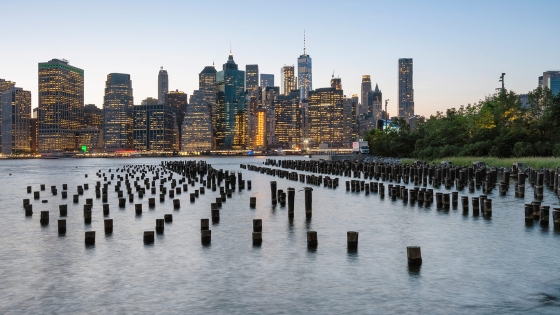Into The Woods (ITW) provides environmental education professional development opportunities for elementary teachers. Teachers are trained in GLOBE protocols and and learn how to implement service learning and citizen science projects with their students. The project is a collaboration between the Queens College-Globe NY Metro progam and the NYU Wallerstein Collaborative. For more information about Into the Woods, visit the Into The Woods website.
Service learning projects include developing school gardens, propagating common milkweed, raising monarch butterflies, coastal cleanups and more.
Examples of Environmental Service Learning
The Wallerstein Collaborative for Urban Environmental Education at NYU served as the service learning partner of the NOAA funded Into the Woods (ITW) program. The Collaborative defines the concept of environmental service learning as a teaching and learning strategy that integrates meaningful community service with instruction and reflection to enrich the learning experience, teach civic responsibility, and strengthen communities.
When working with schools and teachers, sustainability issues in the school community, or environmental needs in the surrounding neighborhood, or natural ecosystems in the community can make for excellent contexts for environmental service learning projects that students and teachers can take ownership of and develop a stewardship ethic towards the environment. The following eight examples depict a sample of the variety of service learning initiatives that were undertaken by the Into the Woods participants.
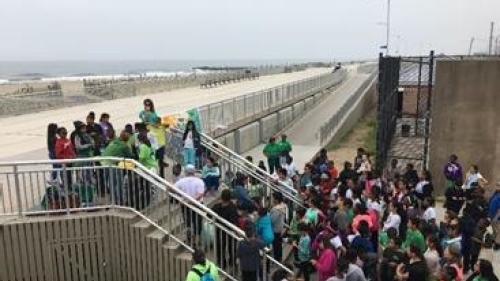
Preservation of Rockaway Beach - Rally for the Future at Rockaway Beach
Christine Scavone’s service learning took off shortly after completing her first year in the program. In year one (2016), she organized a beach cleanup at the Rockaways and her students created a video to increase public awareness about ocean pollution and then made an art project out of plastic waste which they brought to the ITW symposium to share with others. Motivated by her first service learning project, and after attending a Roots and Shoots workshop at NYU, she applied for and received a Roots and Shoots grant with which she launched her second service learning project. Christine further developed the work on plastic pollution in the summer of 2017. Her project extended to other classes and schools and reached a much larger audience, which involved numerous other partners and elected officials. Approximately 150 students and their teachers attended.
Ms. Scavone and her 5th grade class organized the Rally for the Future at Rockaway Beach which took place on May 22, 2017. For this event, the students invited other classes from their school (PS 43) as well as other local schools, including other ITW teachers and their classes. Working in collaboration with the Rockaway Waterfront Alliance and Surfrider Org they organized and lead the day’s activities, which included a beach clean-up and an art-making session with plastic trash. All of the attending students had signs with messages for the community and a select group made speeches with themes like keeping the beach clean, the effects of plastic pollution, and the importance of the coastal ecosystem. At the rally, a representative of the community’s NYC council member made a speech, along with representatives from each of the organizations, including Dr. Mary Leou who represented NYU and the Into the Woods team. Ms. Scavone is currently planning a new project and has reached out to us to help her with finding resources for a marine pollution service learning project to take place in 2018. She and her students have taken ownership of their beachfront community and continue to evolve as leaders in their community.
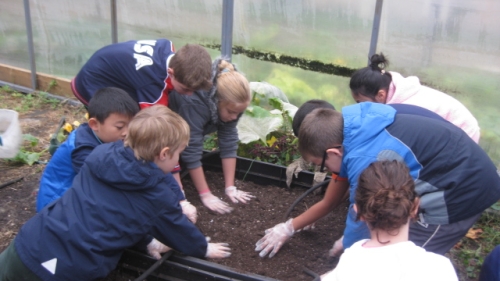
A High Tunnel in Bayside Queens
Ms. Laugen (Cohort 1) from P.S. 205Q worked with her students to reinstate a greenhouse, or “high tunnel,” that had fallen into disrepair into a productive school garden complete with compost bins. After the NYU education team met with Ms. Laugen and the administration, a plan was developed to launch the project. Ms. Laugen’s 4th graders ventured out of the classroom into the garden–weeding, cleaning, and planting the garden beds. Students pulled out weeds while learning about common garden weeds like the ubiquitous mugwort.
Each group of students added fresh soil and planted tomatoes, basil, peas, parsley rosemary and more. The class also planted buddleia and lavender around the school grounds with the help of school custodians to support monarch butterflies and also attract beneficial pollinators. Ms. Laugen enlisted parents to participate in their childrens’ project by helping maintain the garden over the summer. The school community enjoyed an excellent harvest of free, healthy, homegrown vegetables and herbs and also contributed to the school’s beautification. In the first year of ITW, after consulting with NYU staff, Ms.Laugen and her students started a composting operation at the school in which they collected food scraps from the cafeteria and composted them for use in their new garden. This project became a school-wide composting and recycling program which won the 2015 Golden Apple award from NYC’s Department of Sanitation, giving $5,000 to the school to help with the continuation of the gardening, recycling and composting efforts. This waste management effort is an example of an exemplary service learning project that Ms. Laugen and her students were able to implement to serve their school community and the larger public school system.
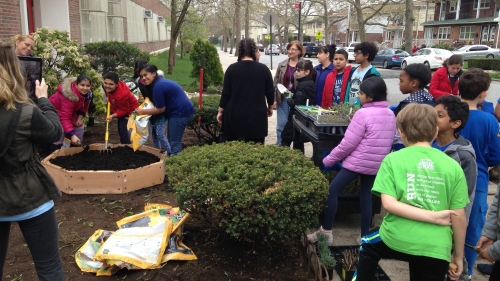
Earth Day Celebration at PS 18Q
Pamela Young (Cohort 2) and her co-teacher Ms. Kay, developed and executed the idea of a learning garden for their science classes at PS 18Q located in Queens, NY. The purpose of this garden is to serve as an outdoor classroom for all the classes in their school. In addition, they have a pen pal school they are working with in Taiwan where the students are also developing a butterfly garden. Ms. Young and Ms. Kay found out about Captain Planet funding sources from the ITW website and wrote and received a Captain Planet grant funded by Boxed.com and Dole. Thus the original service learning project expanded into a school-wide initiative. NYU staff met with them to plan the garden and organize the launch which was tied to their school’s Earth Day Celebration. Ms. Young noted “it truly does take a village! The collaborative efforts of all these people made our dream come true. We learned a valuable lesson through this two year journey...never give up, the garden fairies will show up when you least expect them!” Their learning garden consisted of an edible garden section and a pollinator garden. On April 22nd, 2017, with the help of parents and the PTA, Ms. Young held an amazing Earth Day Celebration with her colleagues, funders, and the Into the Woods team, to plant the two gardens and launch the outdoor classroom. Ms. Young and Ms. Kay organized the event with over 60 PS 18Q students and their parents who helped with the work. The funders and the ITW team helped the students and teachers build the edible garden structures and plant the vegetables, as well as turn the soil, clean the ground, and plant native species at the pollinator garden site. The NYC Parks Department also provided numerous native plants. Pamela noted “We were also introduced to the Greenbelt Native Plant Center in Staten Island. This is a resource that most schools are not aware of.” Ms. Young and Ms. Kay have been using the learning garden every day since it was established, and have big plans for other green areas surrounding their school in partnership with the NYC Parks Department. Sponsors helped create a video of the event. In this case, the service learning project engaged an entire school community with global connections.
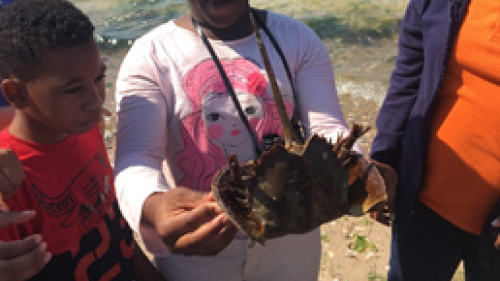
Tidal Connections - Horseshoe Crabs in Plumb Beach
Rochelle Whichard (Cohort 2) from PS 48Q in Jamaica, Queens, participated for the second year in a row in a citizen science program administered by the NYU Wallerstein Collaborative and NYC Audubon called Tidal Connections, which combines citizen science and service learning in Jamaica Bay to protect and monitor horseshoe crabs. Ms. Whichard’s 5th grade class along with two more classes from her school learned about coastal ecology, focusing on the relationship between shorebirds and horseshoe crabs. As an ITW teacher, she enlisted two additional teachers and their classes to participate in this program, and in doing so was able to engage the entire 5th grade in her school (approximately 80 students) in using Plumb Beach as an extension of their classroom.
Each 5th grade class was introduced to the particular habitat of Plumb Beach and the Gateway National Recreation Area by NYU Wallerstein staff who visited the school. The classes were then taken on a field trip to Plumb Beach during the horseshoe crab mating season where they met with NYC Audubon scientists and learned about the importance of horseshoe crabs in relation to shore birds. Students collected data and made observations. The day culminated with a beach cleanup in which the students were able to pick up large amounts of plastic and metal trash. This experience was followed with a post-trip class visit by NYU Wallerstein staff where students reviewed what they learned and discussed ways to develop a campaign to protect this important habitat and how they can be better stewards of New York City’s coastal areas. Children created posters and conservation messages to be posted in their school and shared with the larger community. This now will become an annual project for the students and teachers as we have added 2 more teachers to the project.
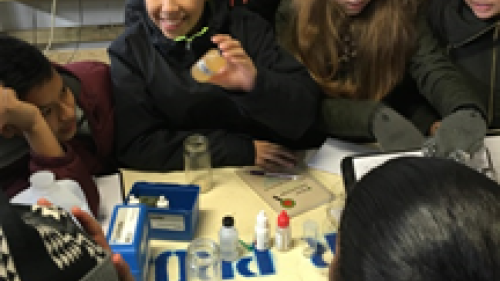
Testing the waters at the Hudson River
In the winter of 2016, three classes of seventh graders (approximately 80 students) from P.S. 498x braved the freezing temperatures to come to Pier 40 in Manhattan to learn about the Hudson River Estuary and to collect water quality data with their teacher, Boris Lazarev, and the environmental educators at the NYU Wallerstein Collaborative. The River Project, a marine biology research field station on Pier 40, hosted the group and offered some protection from the cold wind. The three classes came on three separate days and were able to spend the morning observing the estuary and testing its water. The students were able to talk with scientists at the River Project and observe their cool preserved specimens.
For the data collection, the classes were divided into small groups; each group had a test they were focusing on. The following parameters were measured: salinity, pH, turbidity, dissolved oxygen, phosphates, bacteria, flow, air temperature, and water temperature. The data the students collected at the Hudson River was uploaded to the NYU Hudson website and now is part of a larger citizen science project!
Mr. Lazarev’s classes used the data they collected for their year-long science project in which they compared the Hudson River water to the water in the Bronx River near their school. As we continue to monitor the Hudson River we anticipate Mr. Lazarev will continue to provide us with student generated data on our Hudson River Estuary
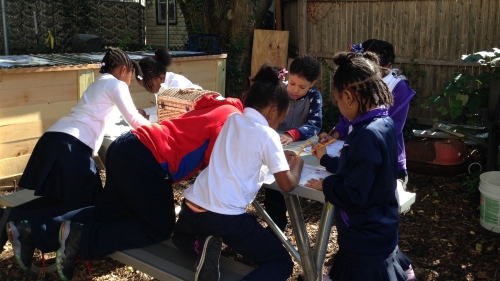
A Garden Grows In Brooklyn
Jeanne Salchli, from P.S. 376 in Brooklyn and her students focused on a social action project involving community gardens. They began by studying community gardens and learning about gardening organizations like GrowNYC and connected with the New York Restoration Project (NYRP) to learn more about gardens and gardening. In 2015 they spent 5 days conducting research in the Bedford Stuyvesant Community Garden. In the garden they searched for signs of life in the garden beds, and compost pile. They learned how to plant seeds and create a garden plan as well as proper techniques for watering, weeding, and composting. They also learned about the importance of studying the ph of soil. and how to grow and maintain healthy fruits and vegetables. Back in the classroom they learned how to write a persuasive letter to Assemblywoman Marita Davila’s Office to find out how to get access to a vacant lot belonging the New York Housing Authority. The Himrod Wilson Community Garden located across the street from their school had been vacant for a long time. The students began a campaign to get access to the lot so that they could start a garden that would be open to the entire school.Two years later they succeeded in getting NYCHA to share their vacant lot and partner with PS 376. (See article)
This is a wonderful success story that exemplifies the spirit of Into the Woods and the power of service learning and civic engagement.

